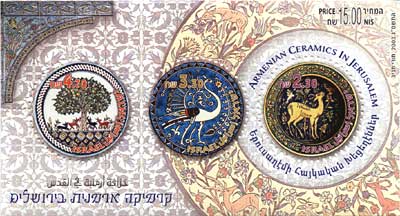|
Armenian ceramic art in Jerusalem originated in the Turkish cities
of Kutahya and Iznik. In these cities Armenian ceramic artists with
Turkish craftsmen, created tiles and pottery for different
clients.
The working methods of the Kutahya and Iznik studios, which were
brought to Jerusalem, involved a designer and a potter. The
potter made the vessel and the head designer sketched his pattern on
perforated paper. The design was transferred on to the vessel and then
colored and fired in the oven.
The work of the Armenian ceramics artists in Jerusalem began in
1919, when David Ohannessian was invited by the British to come to
Jerusalem from Kutahya to renovate the tiles of the Dome of the Rock.
Ohannessian specialized in the production of tiles for monumental
architecture and continued the traditions of Iznik and Kutahya by
uniting geometric and arabesque shapes with floral motifs. Neshan
Balian, the potter and Megherdich Karakashian, the designer worked
with David Ohannessian until 1922 when they left and opened their own
joint studio. Their work and that of their sons, Stepan Karakashian
and Setrak Balian and his wife the designer Marie Balian, – who later
each opened their own studio – represents the breakaway from
traditional repertoire of forms while becoming artists of
Jerusalem.
Early Christian motifs, such as gazelles, birds and vine scrolls,
played a major role in the repertoire of forms used in the
Karakashian-Balian studio’s designs. They were inspired by the ancient
mosaic pavements of the Holy Land. The 6th century “Bird” mosaic in
the Armenian chapel in Jerusalem with memorial inscriptions to the
Armenian unknown soldier, and the “Tree of Life” mosaic pavement from
the Umayyad Palace near Jericho became major themes of the studio.
Thus, this repertoire depicted an imaginary idyllic world of birds,
gazelles, blossoms and tulips, with symbolism that was meaningful for
Christians, Jews and Muslims alike.
The light that is captured by the glazed Armenian ceramic jars and
tiles symbolizes the absorption of divine light on material objects.
The flora and fauna are like miniature mirages. The ceramic
objects function on several levels: on the sensual level of touch, on
the aesthetic level as a vision of paradise and on the symbolic level
as a promise.
Prof. Nurith Kenaan-Kedar
Further reading: The Armenian Ceramics of Jerusalem: Three Generations, 1919-2003, Yad Izhak Ben-Zvi, Eretz-Israel Museum, Tel-Aviv 2003.
The Armenian Ceramics of Jerusalem: Three Generations, 1919-2000, Yad Izhak Ben Zvi, Eretz Israel Museum, Tel Aviv 2001 (in Hebrew).

|
